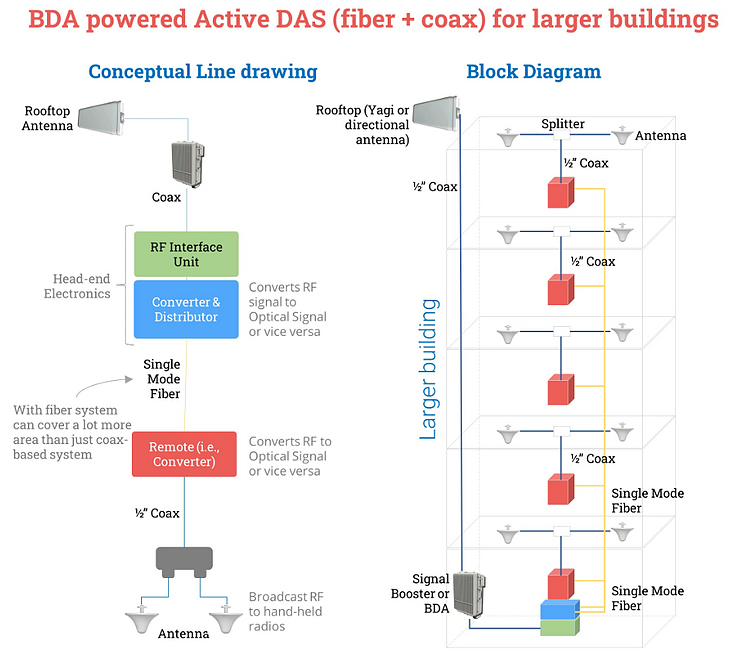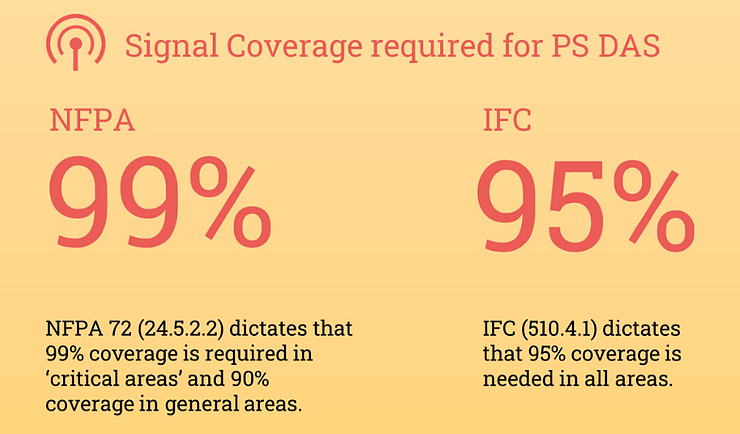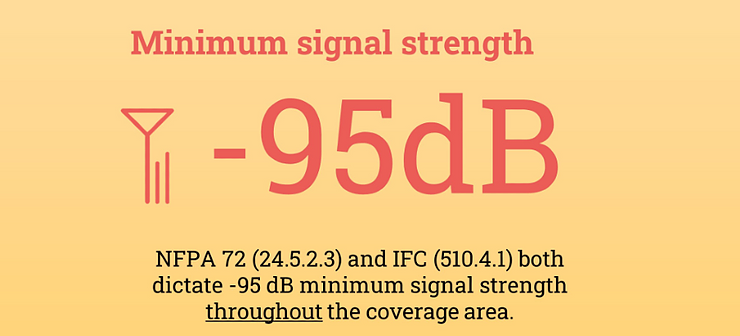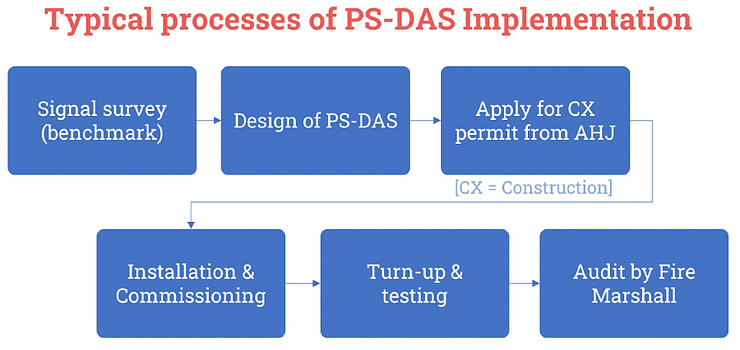Public Safety DAS for New Buildings: a primer for Architects, Construction Managers, and RCDDs
[To download a cheat sheet that summarizes the article in 3 pages, please contact us. This is a good resource to keep handy - especially for the IFC and NFPA guidelines reference.]
Public Safety communication revolves around the signal needed for the first or emergency responders. A first responder is a person who is likely to be among the ‘first’ trained people to arrive at and assist at the scene of an emergency such as an accident, natural disaster, or terrorist attack, etc. (Wikipedia) First responders must be able to communicate with each other during the time of crisis.
Public Safety officials always broadcast signals in certain (FCC-mandated) frequencies. But sometimes these signals cannot penetrate the building you are in. For example, newly-built LEED-certified buildings with low-E glass windows often suffer from poor radio signal coverage due to signal attenuation caused by this special kind of glass windows. In cases like these, building owners are requested to install a Public Safety DAS (PS-DAS) network inside the building. Increasingly, cities are making PS-DAS mandatory and pre-requisite for occupancy of newly constructed buildings if sufficient public safety signals are not present indoor.
DAS stands for Distributed Antenna Systems. It is a wireless network (indoor or outdoor) for licensed frequencies (not Wi-Fi).
Public Safety DAS has different names
The most common type of public safety DAS
It operates on a simple borrow-boost-distribute formula.
Borrow signal from a near-by radio tower: Usually, you will have to place a directional antenna on the roof of the building facing towards a near-by public safety tower. Directional antennas transmit and receive signals in a specific direction.
Amplify or boost the signal it-and then: borrowed signal will be routed to a signal booster (also known as a bi-directional amplifier or BDA) via a coaxial cable
Distribute the signal where needed: the output of the signal booster will be routed to strategically located indoor antennas inside the buildings so that it can reach the hand-held radios.
Coaxial DAS works well for buildings with an average area of 400K sq. ft. or less (this is an approximation, exact area that can be covered with a coax based PS-DAS depend on multiple factors). For bigger buildings, we use Active DAS – a DAS that uses both cox and fiber. But before we get into Active DAS, let’s find out the principal factors that impact the design of a Public Safety DAS.
Factors that determine the number of indoor antennas and type of DAS
Coverage Area: The number of antennas is usually proportional to the area you are trying to cover. Greater the area of coverage, more antennas you will need. the actual number of antennas will be determined through engineering analysis.
Signal frequencies: Signals with lower frequencies usually travel a longer distance than higher frequencies. FCC lists the following frequencies for the public safety spectrum. However, most common bands used for public safety are VHF, UHF, 700 & 800 bands.
Public Safety frequencies issued by FCC
Local fire codes will tell you what frequencies need to be used at your building.
The number of inside walls: the general rule is more walls signal runs into, less distance it will travel, which means more antennas will be needed.
Type of walls: As the signal passes through the walls, it loses strength. The amount of lost signal depends on the type of wall. For example, the signal will lose more power going through a concrete wall than drywall. This means building with mostly concrete walls may need more antennas than a building with mostly dry walls even though the 2 buildings have the same size.
PS-DAS for a bigger building
We deploy a mix of coaxial and fiber-based DAS for bigger buildings. This DAS is known as Active DAS. Active DAS helps to scale up the DAS by clever use of fiber and optical signal and allows the DAS to cover a much larger area than a coaxial cable-based system can. Active DAS also operates on a simple borrow-boost-distribute formula.
Borrow signal from a near-by radio tower: Place a directional antenna on the roof of the building facing towards a near-by cell tower.
Amplify or boost the signal it: borrowed signal will be routed to a signal booster or BDA via a coaxial cable.
Distribute the signal where needed:
The output of the signal booster is routed to a cluster of electronics – commonly known as ‘head-end’ electronics - to convert the RF to the optical signal.
The optical signal is now routed to another electronics – usually known as ‘remote’ electronic. This ‘remote’ converts the optical signal back to the RF signal. Remote sends the RF Signal to several antennas that are connected to the remote via coaxial cable. The antennas are strategically located inside the building. The locations of the antennas are determined through engineering analysis (as mentioned before).
The RF signal comes out of the antennas and establishes a connection with the hand-held radios.
Note that the block diagram shown in this section is the most common type of PS-DAS architecture for an Active DAS. You may, however, run into DAS configurations which may be somewhat different – for example, DAS with CAT6A cable, or DAS with all fiber cable and minimal to no coax.
The technical configuration for PS-DAS is relatively simple (compared to the indoor cellular network). However, the important part is to figure out what kind of local rules and ordinances will apply when you are building the PS-DAS. These rules can vary to some degree depending on the jurisdiction the building is located at. To understand this variance at the local level, lets first look at the national or international guidelines that form the basis of local rules.
NFPA & IFC guidelines for Public Safety DAS
The following diagram gives a quick overview of how entities develop policies or guidelines for PS-DAS:
Which entities decide policies for Public Safety DAS
FCC (Federal Communications Commission) decides the frequency that can be used for PS-DAS
2 national organizations - ICC (International Code Council) or NFPA (National Fire Protection Association) guidelines address signal strength & coverage, design & configuration, system tests & monitoring, power, etc. AHJ (Authority Having Jurisdiction) can adopt or amend guidelines from either or both ICC or NFPA to enforce in the area. AHJ stands for Authority Having Jurisdiction – for example, City, County, Fire Marshall's office.
ICC guidelines for PS-DAS are known as International Fire Code: Section 510 of IFC provides guidelines to be followed for Public Safety DAS. Section 510 has been widely adopted and amended by a lot of AHJs (Authority Having Jurisdiction). IFC revises and updates its guidelines every few years.
NFPA guidelines for PS-DAS are recorded in NFPA 72 - National Fire Alarm and Signaling Code, which provides the latest safety provisions to meet fire detection and emergency communications demands. Chapter 24 of NFPA 72 focuses on Emergency Communications Systems (ECS). NFPA also has another lesser-known set of guidelines – NFPA 1221 – which specifies a standard for the installation, maintenance, and use of emergency services communications systems and covers all aspects of service delivery, from receiving calls to dispatching emergency units to the correct location in the appropriate time period.
In addition to IFC and NFPA, there are other organizations who have also developed their guidelines pertinent to PS-DAS:
1. International Code Council (ICC)
2. International Building Code (IBC)
3. First Responder Network Authority (FirstNet).
Understanding local codes is key!
As stated above, most AHJs are adopting the language from IFC or NFPA codes rather than developing their own ordinances. Local jurisdictions may also use ordinances written by a few other organizations to build their own, including ICC, IBC as mentioned above. Understanding local codes are, therefore, instrumental, since there’s no unified set of rules set at the federal level, every jurisdiction has slightly different ordinances.
Major items covered by NFPA or IFC
It’s important for architects, building owners, facilities managers, constructors to have some working ideas of the few major topics covered by these guidelines.
Coverage required
Minimum signal strength
Permit
Signal Booster or BDA
Equipment enclosures
Stand-by Power
System monitoring alarms
Grid testing
Coverage required for public safety DAS:
While a typical cellular DAS Design covers the usual areas we use, for example, office rooms, meeting rooms, break rooms, etc. These are not always the areas where emergency responders are during a crisis. Many times, they’re trying to get to hard-to-reach and uncommon places such as equipment rooms, basements, stairwells, and elevators.
Signal coverage mandated by NFPA and IFC
NFPA 72 (24.5.2.2) dictates that 99% of coverage is required in critical areas. NFPA codes define Critical Areas as any of the following: fire command center(s), the fire pump room(s), exit stairs, exit passageways, elevator lobbies, standpipe cabinets, sprinkler sectional valve locations, and other areas deemed critical by the local authority that have jurisdiction.
In addition to this, NFPA also wants to have 90% coverage in general areas.
IFC (510.4.1), on the other hand, dictates that 95% coverage is needed in ALL areas.
So, depending on what your local jurisdiction is following, most likely the coverage requirement will be either 95% or 99%.
IFC Section 510.1 requires public safety radio coverage within all new buildings unless local fire code officials make an exception. Again, the local code is the king. Another exception IFC 510.1 has made is when the signal of public safety may have a negative impact on the normal operations of the facility.
Minimum signal strength:
NFPA 72 (24.5.2.3) and IFC both dictate that you will need a minimum of -95 dB (decibel) signal strength throughout the coverage area. dB stands for decibel. That is a really small number in watts, but good enough to maintain acceptable communications. Also, note that there is a minus sign before 95 dB. That means numbers such as -90 dB or -85 dB are greater than -95 dB.
Minimum signal strength mandated by NFPA 72 and IFC
Permit:
IFC (sections 510.3 and 105.7.5) requires that a construction permit will be needed for the installation or modification to PS-DAS systems and related equipment. However, if maintenance is performed on an existing system construction permit will not be required.
Signal Booster or BDA:
Both NFPA (24.5.2.2.3) and IFC (510.4.2.1) ask for the Federal Communications Commission (FCC)-certified signal boosters. There is also a relatively new requirement - UL2524 released (on 2nd edition only). UL2524 basically asks for compliance to NFPA 1221, National Electrical Code (NFPA 70), Fire Code (NFPA 1), Life Safety Code, NFPA 101.
NEMA-4 Equipment Enclosures:
NFPA (24.5.2.5.2) and IFC (510.4.2.4) dictate that all equipment supporting the public safety network needs to be housed in a NEMA-4 compliant enclosure. This includes equipment such as radios and power systems. NEMA is an abbreviation for National Electrical Manufacturer Association (NEMA). NEMA-4 is a rating for an enclosure.
Stand-by Power:
IFC (510.4.2.3, 604.2.3) dictate that the standby power supply should be capable of operating the emergency responder radio coverage system (i.e., PS-DAS) for a duration of not less than 24 hours.
NFPA (24.5.2.5.5) requires that at least two independent and reliable power supplies shall be provided for all signal booster components, one primary and one secondary. The primary power source shall be supplied from a dedicated branch circuit. The secondary power source shall consist of one of the following:
1. Batteries: A storage battery dedicated to the system with at least 12 hours of 100 percent system operation capacity.
2. Generator: An automatic starting, engine-driven generator serving the dedicated branch circuit or the system with at least 12 hours of 100 percent system operation capacity and storage batteries dedicated to the system with at least 2 hours of 100 percent system operation capacity.
System Monitoring Alarms:
While both the NFPA and IFC require an alarm system, they’re different in their requirements.
IFC (510.4.2.4) basically asks for the BDA and battery system to be electrically supervised and monitored. Also, if approved by the fire code official, the signal booster can sound an audible signal at a constantly attended location.
NFPA has more detailed requirements of System Monitoring than IFC. So, if your AHJ adopts NFPA rules for PS-DAS, your DAS integrator will have to abide by section 24.5.2.6 of NFPA. It requires System Monitoring through Fire Alarm System (24.5.2.6.1) and Dedicated Panel (24.5.2.6.2). These sections require various monitoring that includes but not limited to signal booster failure, loss of normal AC power, failure of battery charger, low-battery capacity, etc.
Grid Testing:
IFC (510.5.3) requires public safety coverage to be tested according to a “20 grid” or “40 grid” process. In grid testing, each floor of a building is split into 20 or 40 sections, and each section is tested using a public safety radio to ensure that there is connectivity and that the signal meets minimum downlink and uplink requirements.
FirstNet: future of Public Safety DAS
Today, first responders rely on more than 10,000 separate, incompatible, and often proprietary radio networks to communicate with each other during emergencies. Since they’re not connected on ONE network, it’s hard, and at times impossible, for emergency responders from different jurisdictions or agencies to communicate and work together to save lives.
This situation was evident in the aftermath of the 9/11 terrorist attacks. 9/11 Commission Report identified gaps in emergency communications and recommended a nationwide network for law enforcement, fire, and emergency medical personnel communications.
Public safety organizations and associations advocated before Congress for a dedicated, reliable wireless network for first responders. Their advocacy efforts led to the passage of legislation in 2012 to create the agency to deploy the Network in all U.S. states and territories, including rural communities and tribal nations. This gave birth to FirstNet. FirstNet is a single, nationwide, interoperable, LTE network dedicated spectrum to public safety communications (Band 14). Band 14 represents 20 MHz of highly desirable spectrum in the 700 MHz band.
FirstNet provides ‘always on’ priority and preemption for access to the network even during times of network congestion. AT&T has the contract to build this network.
All 50 states, five U.S. territories and Washington, D.C., have “opted in,” to FirstNet, meaning each has accepted its individual State Plan detailing how the network will be deployed in their state/territory (firstnet.gov).
This also means that if your AHJ has not adopted FirstNet yet, it’s just a matter of time. Keep in mind though if you must install a Public Safety (FirstNet compatible) DAS in your building you will still have to follow the rules in this article.
Overview of a PS-DAS project: from survey to turn-up
Following is a block diagram of typical processes involved in deploying a Public Safety DAS. In most cases, you can find a qualified vendor (i.e., System Integrator) who can take care of all the steps mentioned below. Once you have the knowledge of these processes though, it will help you vet the right system integrator.
Signal Survey or Benchmark Study:
The implementation process starts with a benchmark study. In a benchmark study, a surveyor will work around the building with a scanner (i.e., spectrum analyzer) and collect the signal on public safety frequency assigned to the area. The deliverable will have all the measured signal-readings on the floor plan.
If it’s a new building you are planning to build, most likely you don’t have the building to survey yet. As soon as the exterior walls & windows go up, you can have your vendor walk the floors to complete a benchmark study. The deliverable (signal superimposed on the floor plan) from the benchmark can be used to determine if the whole building will need DAS or just part of the building. Our experience is a mixed bag… we have done a benchmark study on new buildings where no PS-DAS was needed. In some cases, we had to build PS-DAS for the whole building. We have also run into buildings where only lower floors (e.g., basement & first floors) needed PS-DAS.
Benchmark study can save you from spending money on the whole PS-DAS. In the worst-case scenario, even if must build the DAS, your engineers will know the coverage objective for each floor to meet the AHJ requirement.
Design of PS-DAS:
A DAS engineer will use a program like iBwave to analyze all the factors mentioned above and come up with:
1. Number of antennas needed,
2. Proposed locations of these antennas & electronics on the floor plan and
3. Proposed cable route
4. A logical diagram – which is a block diagram that shows how all electronics and passive materials (e.g., cable, antenna, splitters, etc.) are connected
5. Lists of materials needed for the DAS. Materials will include quantities and types of all electronics needed to make the PS-DAS operational and compliant of the local codes. Materials will also include all passive or infrastructure materials such as coaxial & fiber cable, connectors, splitters & couplers, antennas, etc.
Permit:
Find out what your AHJ (e.g., Fire Marshall’s office) needs to submit an application for a construction permit. Sometimes you may have to get multiple permits – for example, a construction permit from the County in addition to the permit from Fire Marshall’s office.
Construction & Testing:
Construction activities will include but not limited to installing all the passive materials such as coaxial and/or fiber cable, BDA, Head-end & Remote electronics (for Active DAS).
Once the construction is completed, cables need to go through sweep testing (to verify continuity of signal flow), fiber cable needs to go through OTDR testing, and the installed system needs to go through CW or Continuous Wave testing. CW testing ensures the signal is flowing through the system (i.e., the measured value of signal input & output should be close to calculated values).
Commissioning & Turn-up:
Commissioning is basically configuring the parameters of BDA and all other electronics (for an Active DAS). This process gets the system ready for the signal and turns up the system. It’s a good practice to do thorough testing with a Spectrum Analyzer (Spec-A) to make sure that PS-DAS is providing -95 dB signal strength at 90-95% of the building area. This Spec-A test can also be done during the CW testing mentioned above.
Audit by AHJ (e.g., Fire Marshall):
Once the system is turned up, notify the Fire Marshall’s office so that an Inspector can come to audit the system. The inspector may do grid tests as described earlier.
That was a typical flow of processes for PS-DAS. This can vary a little from project to project, but the basics will be the same in most cases.
If you need to deploy a Public Safety DAS, please contact us for a hassle-free experience.











